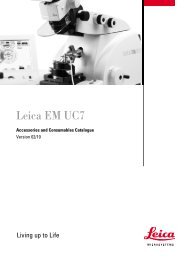Physical Principles of Electron Microscopy: An Introduction to TEM ...
Physical Principles of Electron Microscopy: An Introduction to TEM ...
Physical Principles of Electron Microscopy: An Introduction to TEM ...
Create successful ePaper yourself
Turn your PDF publications into a flip-book with our unique Google optimized e-Paper software.
The Transmission <strong>Electron</strong> Microscope 71<br />
through the specimen should fall within this diameter, which is equivalent <strong>to</strong><br />
a diameter <strong>of</strong> (15 cm)/M = 1.5 �m at the specimen. For viewing larger areas<br />
<strong>of</strong> specimen, however, the final-image magnification might need <strong>to</strong> be as<br />
low as 2000, requiring an illumination diameter <strong>of</strong> 75 �m at the specimen. In<br />
order <strong>to</strong> achieve the required flexibility, the condenser-lens system must<br />
contain at least two electron lenses.<br />
The first condenser (C1) lens is a strong magnetic lens, with a focal<br />
length f that may be as small as 2 mm. Using the virtual electron source<br />
(diameter ds) as its object, C1 produces a real image <strong>of</strong> diameter d1. Because<br />
the lens is located 20 cm or more below the object, the object distance u �<br />
20 cm >> f and so the image distance v � f according <strong>to</strong> Eq. (2.2). The<br />
magnification fac<strong>to</strong>r <strong>of</strong> C1 is therefore M = v / u � f /u � (2 mm) / (200 mm)<br />
= 1/100, corresponding <strong>to</strong> demagnification by a fac<strong>to</strong>r <strong>of</strong> a hundred. For a<br />
W-filament electron source, ds � 40 �m, giving d1 � Mds = (0.01)(40 �m) =<br />
0.4 �m. In practice, the C1 lens current can be adjusted <strong>to</strong> give several<br />
different values <strong>of</strong> d1, using a control that is <strong>of</strong>ten labeled “spot size”.<br />
equivalent<br />
lens action<br />
� 1 � 1<br />
cathode<br />
Wehnelt<br />
crossover<br />
equipotential<br />
surfaces<br />
virtual source<br />
anode plate<br />
Figure 3-7. Lens action within the accelerating field <strong>of</strong> an electron gun, between the electron<br />
source and the anode. Curvature <strong>of</strong> the equipotential surfaces around the hole in the Wehnelt<br />
electrode constitutes a converging electrostatic lens (equivalent <strong>to</strong> a convex lens in light<br />
optics), whereas the nonuniform field just above the aperture in the anode creates a diverging<br />
lens (the equivalent <strong>of</strong> a concave lens in light optics).



